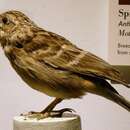en
names in breadcrumbs


According to The Birds of North America, Sprague's pipits are "one of the least-known birds in North America." Named after Isaac Sprague, who discovered these birds near Fort Union, N.D. in June of 1943.
Sprague's pipits generally only make calls that are short "squicks." Only males are known to sing, and only during their aerial display. Male songs are high pitched and last 2 to 3 seconds. Nestlings can make noises at age 10 to 11 days.
Communication Channels: visual ; acoustic
Perception Channels: visual ; tactile ; acoustic ; chemical
Sprague's pipits are considered vulnerable because of a rapid population decline of about 32% that has been documented since the 1970's. The major threats to this species are considered habitat loss and degradation resulting from land conversion to agriculture.
US Migratory Bird Act: protected
US Federal List: no special status
CITES: no special status
State of Michigan List: no special status
IUCN Red List of Threatened Species: vulnerable
There are no adverse effects of Sprague's pipits on humans.
Sprague's pipits have no known economic importance to humans, aside from their role as parts of healthy, prairie ecosystems.
Broods of Sprague's pipits are parasitized by brown-headed cowbirds, but less so than other prairie-dwelling birds. They are also parasitized by the feather mites Proctophyllodes anthi and P. polyxenus. Sprague's pipits forages for insects and also feed on seeds.
Commensal/Parasitic Species:
Sprague's pipits eat mostly arthropods during breeding season, and some seeds too. They forage in grasses on their own during the daytime. They eat spurge seeds, grasshoppers, crickets, false cinch bugs, weevils, stink bugs, ants, leaf beetles, beetles, and caterpillars. Females bring small invertebrates to the young to eat.
Animal Foods: insects
Plant Foods: seeds, grains, and nuts
Primary Diet: omnivore
Anthus spragueii breeds in the northern prairies of the Great Plains, it’s northern limit is Saskatchewan, with it’s western limit near the Rocky Mountains. Anthus spragueii can also be found in the Dakotas, western Minnesota, Montana, and parts of British Columbia. Anthus spragueii winters in Arizona, New Mexico, Texas, Oklahoma, Arkansas, Mississippi, Louisiana, and areas in Northern Mexico. It has also been observed in Michigan, western Ontario, Ohio, and Massachusetts.
Biogeographic Regions: nearctic (Native )
Sprague's pipits prefer grassland with few shrubs and high visibility. They prefer native grasses like wheatgrass, June grass, blue grama, Canby blue, green needle grass, smooth brome, and crested wheat.
Range elevation: 1307 to 1513 m.
Habitat Regions: temperate ; terrestrial
Terrestrial Biomes: savanna or grassland
Other Habitat Features: agricultural
Little is known about the lifespan of Sprague's pipits.
Lacking some of the brighter colors found in other pipits, Sprague's pipits are well camouflaged in prairie grasses. The plumage is a tan color highlighted by streaks of white and black, with white outer tail feathers. Sprague's pipits have pinkish yellow legs, dark eyes, and a small cream colored beak. Females show an increase in mass during the mating season. Young are covered in gray down upon hatching and have transparent skin.
Range mass: 22 to 26 g.
Range length: 10 to 15 cm.
Range wingspan: 76 to 83 mm.
Average wingspan: 80 mm.
Other Physical Features: endothermic ; homoiothermic; bilateral symmetry
Sexual Dimorphism: sexes alike
Little is known about predators of Sprague's pipits, but carnivorous mammals, such as weasels, and snakes are suspected as predators of eggs and nestlings. Raptors may take fledglings and adults.
Known Predators:
Anti-predator Adaptations: cryptic
Little is known about the mating systems of Anthus spragueii. During mating season Sprague's pipits are monogamous. Other pipits are known to perform aerial displays to attract mates.
Mating System: monogamous
In Saskatchewan Sprague's pipits take 3 to 4 months to raise a clutch. The season begins the second week of May and extends into July. Mates produce an average of 1.5 clutches per year with a clutch consisting of roughly 4.5 eggs. Nests are built on the ground in grassland near dense grass. Females collect dried grass 5 to 15 cm in length to weave into a nest. Sometimes females will build a canopy out of grass, creating a dome over the nest. The nest interior is approximately 7.6 cm in diameter, 3.8 cm in depth, with a 5.1 cm entrance hole. New nests are built for every brood. The incubation period is 13 to 14 days. There is little information about the age of sexual maturity in Sprague's pipits.
Breeding interval: Sprague's pipits have an average of 1.5 clutches each breeding season.
Breeding season: The breeding season begins in early May and lasts until July.
Range eggs per season: 4 to 7.
Average eggs per season: 4.5.
Range time to hatching: 11 to 14 days.
Range fledging age: 10 to 11 days.
Range time to independence: 10 to 11 days.
Key Reproductive Features: iteroparous ; seasonal breeding ; gonochoric/gonochoristic/dioecious (sexes separate); sexual ; oviparous
Females incubate the eggs over a 13 to 14 day period. During the pre-fledgling period (which lasts 10 to 11 days) Females provide all care. It has been suggested that males may take over care after young leave the nest.
Parental Investment: altricial ; pre-fertilization (Provisioning, Protecting: Female); pre-hatching/birth (Provisioning: Female, Protecting: Female); pre-weaning/fledging (Provisioning: Female, Protecting: Female); pre-independence (Provisioning: Male, Protecting: Male)